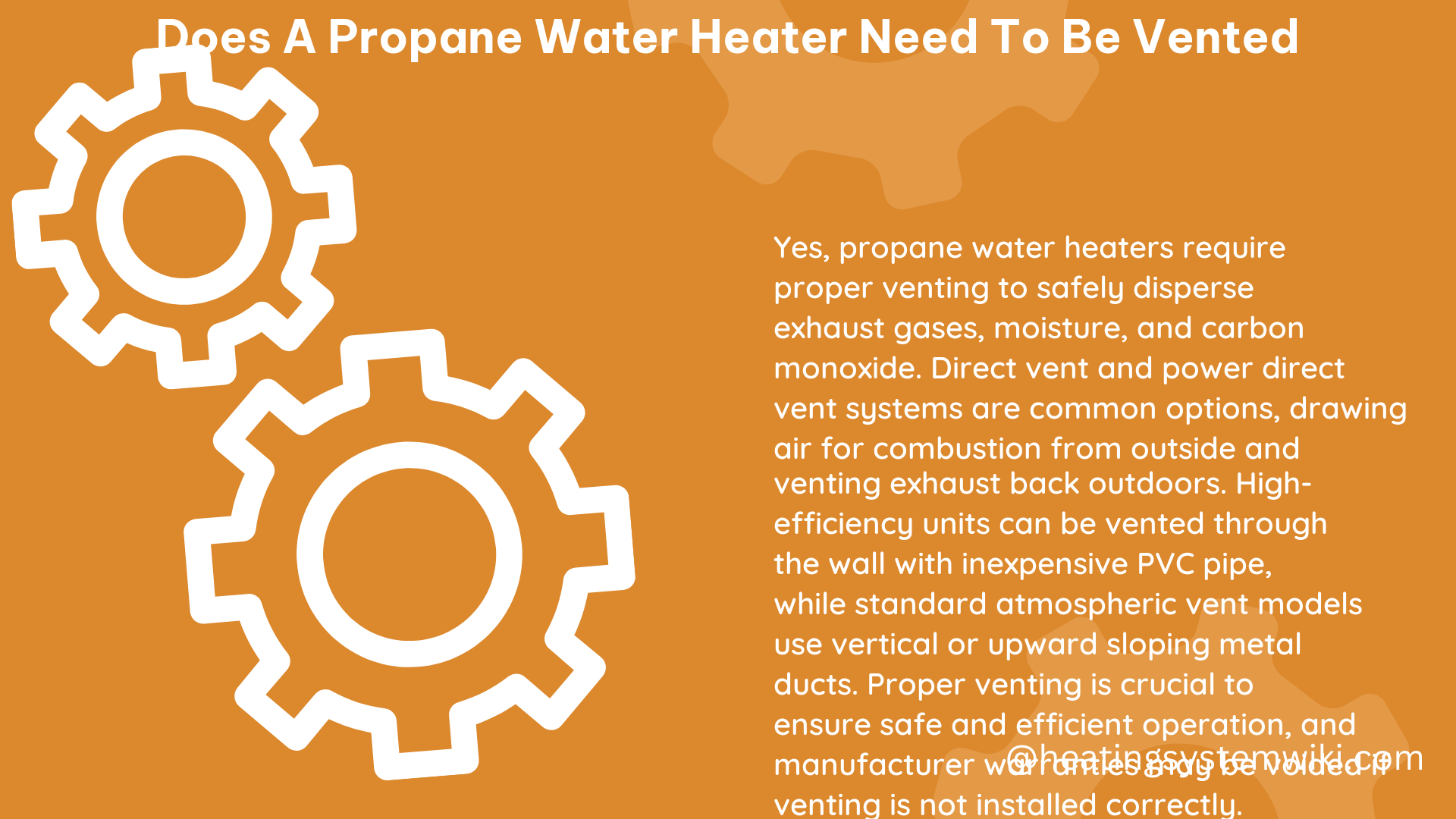A propane water heater must be properly vented to ensure safe and efficient operation. Venting helps to disperse the moisture, carbon monoxide, and other gases produced during the combustion process. The type of venting required depends on the specific model and design of the water heater.
Atmospheric Vent Water Heaters
For standard atmospheric vent water heaters, the exhaust is vented through a vertical or upward-sloping metal duct. This venting can be dedicated to the water heater or shared with other atmospheric vent appliances, such as a furnace. The venting must be oriented vertically or with an upward slope to allow the hot exhaust to rise and exit the home.
The size of the vent pipe is crucial for proper venting. Atmospheric vent water heaters typically require a 3-inch or 4-inch diameter vent pipe, depending on the BTU rating of the unit. The vent pipe must be made of corrosion-resistant materials, such as galvanized steel or stainless steel, to withstand the high temperatures and acidic condensation produced during operation.
The vent pipe should be as short and straight as possible, with a minimum number of elbows or bends. Each elbow or bend introduces additional resistance to the exhaust flow, which can reduce the efficiency of the venting system. The vent pipe should also be properly insulated to prevent heat loss and condensation buildup.
Power Vent Water Heaters

Power vent water heaters are equipped with an electric blower fan installed on top of the unit. This blower fan pushes the exhaust and excess heat through the venting system. The venting for a power vent water heater can run either vertically or horizontally, providing more flexibility in the installation.
The size of the vent pipe for a power vent water heater is typically smaller than an atmospheric vent, often ranging from 2 inches to 3 inches in diameter. The blower fan provides the necessary suction to effectively vent the exhaust, allowing for longer vent runs and more bends or elbows compared to an atmospheric vent system.
Power vent water heaters require an electrical outlet near the unit to power the blower fan. The electrical connection must be properly grounded and installed by a licensed electrician to ensure safe operation.
Direct Vent Water Heaters
Direct vent water heaters are designed for installations where there is insufficient ventilation within the space. These units draw air for combustion from outside the home, rather than from the indoor air. The exhaust gases and excess heat are then vented back outdoors.
Direct vent water heaters typically use a coaxial vent pipe, which consists of a smaller inner pipe for the exhaust and a larger outer pipe for the intake air. This concentric venting design allows for a single wall or roof penetration, providing a more aesthetic installation.
The size of the coaxial vent pipe for a direct vent water heater is usually 3 inches or 4 inches in diameter, depending on the BTU rating of the unit. The vent pipe must be properly sealed and secured to prevent any leaks or backdrafting of exhaust gases.
Power Direct Vent Water Heaters
Power direct vent water heaters are a variation of the direct vent design, incorporating an electric blower fan to assist with the venting. These units are used in situations where the installation space lacks sufficient air for combustion and requires more flexibility in the venting configuration.
The power direct vent system allows for longer vent runs and more bends or elbows compared to a standard direct vent system. The blower fan provides the necessary suction to effectively vent the exhaust, similar to a power vent water heater.
Like power vent water heaters, power direct vent units require an electrical outlet near the unit to power the blower fan. The electrical connection must be properly grounded and installed by a licensed electrician.
Improper Venting Consequences
Improper venting of a propane water heater can lead to serious safety issues. If the venting is not installed correctly or becomes obstructed, it can cause the water heater to backfire or overheat. This can trigger the thermal release device (TRD), which is a safety mechanism that shuts down the gas valve and prevents the unit from firing.
Backfiring or overheating can also lead to the buildup of carbon monoxide, a highly toxic gas that can be deadly if it accumulates in the home. Proper venting is essential to ensure the safe and efficient operation of a propane water heater.
Importance of Professional Installation
Due to the critical nature of water heater venting, it is highly recommended to have a professional plumbing contractor handle the installation. Venting issues are one of the most common problems encountered with water heater installations, and a qualified technician can ensure the proper sizing, configuration, and installation of the venting system.
Attempting to install or modify the venting system without the proper knowledge and expertise can be dangerous and may violate local building codes or safety regulations. A professional plumber will have the necessary experience and tools to properly assess the installation site, select the appropriate venting components, and ensure the water heater is vented in accordance with the manufacturer’s specifications and local requirements.
By working with a professional, you can have peace of mind knowing that your propane water heater is installed safely and will operate efficiently, reducing the risk of potential issues or hazards.
References:
– Venting 101: Understanding Water Heater Venting
– Propane Tankless Water Heater Myths
– Water Heater Venting: What You Need to Know
